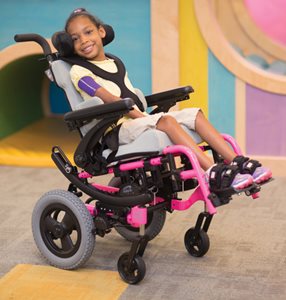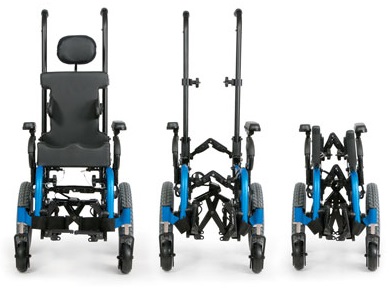Hands down my favorite animated show of all time is Hanna-Barbara's The Jetsons. In the mid-1980's when I was growing up, reruns of The Jetsons came on after school. My sister and I would rush through our homework just so we could be done in time to watch the show. We were mesmerized by all of the cool space-age technology. From the machine that allowed Jane Jetson to get completely ready for her day (brushing her teeth, hair, make-up, dressing...everything) with the press of a button to George's car that folded up conveniently into a small briefcase that he could easily carry into work. Looking back I believe that The Jetsons played a role in inspiring me to think outside the box and learn more about how technology can change the lives of people living with disabilities.
One of the most frequently asked questions from parents and/or caregivers I have heard throughout my years of working in the world of Assistive Technology in relation to wheelchairs is&..."How are we going to transport that thing?" The reality is that in many cases transporting wheeled mobility devices is not easy. Unfortunately, George Jetson's car that folds up with the push of a button into a lightweight briefcase has not yet been invented, much less a wheelchair that can do the same. Discussing the portability and transport options of a wheelchair and seating system is an integral part of the early stages of the evaluation process.
There are numerous reasons as to why selecting a manual wheelchair with a tilt-in-space system may be beneficial to a client including, but not limited to, positioning for function (breathing, vision, eating, communication, switch access, etc.) and pressure relief. Oftentimes clinicians and complex rehab technology suppliers are conflicted between recommending what is therapeutically appropriate from the positioning and mobility standpoint for the client, with exactly what the family and caregivers are able to manage on a daily basis.
In order to help with the decision making process for pediatric tilt-in-space wheelchairs, let's take a high level look at a few options related to breaking down pediatric tilt-in-space wheelchairs offered by Sunrise Medical:
Zippie® TS

The Zippie TS is the original premier pediatric tilt-in-space wheelchair. It offers 45 degrees of tilt via a fixed pivot point mechanism, which can be operated by a caregiver via dual triggers mounted under the push handles or a foot release tilt actuator. Seating options for the Zippie TS range from standard cushion and back options such as the JAY Zip™ Cushion and JAY Zip Back to fully adaptive seating.
The wheelchair frame is available in two options: rigid and folding. The folding frame version features a crossbrace that allows the chair to be folded vertically. Depending on the overall configuration of the wheelchair and seating system (cushion, back, and positioning components), a folding frame Zippie TS can have its seating system removed, back canes folded down, and the base of the wheelchair folded vertically via the crossbrace. It is important to note with any wheelchair, the weight and size of the frame, seating system, and additional components will likely vary because each wheelchair is built to meet the needs of each individual user.
Zippie IRIS®

Over 10 years ago the team of engineers and product developers at Sunrise Medical revolutionized the wheelchair industry by designing a tilt-in-space wheelchair that is more user- and caregiver-friendly. The patented technology was named Intelligent Rotation in Space, or IRIS. What makes the IRIS frame unique is that it rotates around the user's center of gravity. The rotation arm is designed to ensure a smooth tilting motion so that the user remains secure and comfortable while significantly decreasing the abrupt movement that is often associated with single fixed pivot point tilt-in-space wheelchairs which can cause the user to be startled. An added benefit of the IRIS technology is that the tilting system's overall mechanics makes it easier for caregivers to control.
The Zippie IRIS has continually evolved over the years with various enhancements and has remained the industry leader in terms of tilt-in-space wheelchairs since it was created. Caregivers, clinicians, and complex rehab technology suppliers all over the world consider the IRIS to be the best tilt-in-space option on the market because of its patented rotation-in-space technology.
The seating systems available on the Zippie IRIS are similar to the Zippie TS. Both standard seating and fully personalized seating systems can be utilized on the Zippie IRIS frame. The original Zippie IRIS was only available in a rigid frame, which meant that while the seating system and other components could be removed, and the backcanes could fold down, the frame did not have a crossbrace to allow for vertical folding.
Zippie IRIS with XLOCK Folding Crossbrace – The best of both worlds

It can be difficult to find the happy medium between what is therapeutically the best option for the client and what the caregivers are able to manage on a daily basis. The product management team and engineers heard the feedback from clinicians, suppliers, and caregivers that the IRIS technology is top notch, but designing a version of the Zippie IRIS base that could fold would take the product to a new level and meet the needs of more families. In May 2016 the Sunrise Medical team was proud to launch the folding frame version of the Zippie IRIS. The folding Zippie IRIS incorporates the industry leading rotation-in-space technology with the patented XLOCK folding crossbrace that fully locks when unfolded for superior rigidity and folds into a compact size for convenient transport. George and Jane Jetson would certainly approve of the innovation found in the folding Zippie IRIS.
With all of the modifications available for wheelchairs and seating systems, it's essential that the client's team works closely to ensure the most appropriate equipment is secured. Reaching out to the local Sunrise Medical account manager may also be beneficial to stay abreast of the latest technology available.
Thank you for reading our blog! We love hearing from you, so please do not hesitate to reach out to us. We encourage you to leave a comment or send us an email.
Always remember at the end of the day, your client is your number one priority!
- Angie
Follow Angie on Twitter @ATigerKiger